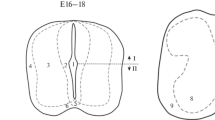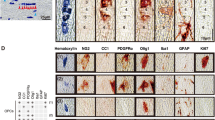Summary
Electron microscopy of subependymal cells and microglia in rat neonatal spinal cord reveals the latter to be a distinctive group of non-neuronal elements characterized by pronounced heterochromatin nuclei, many free ribosomes and rosettes, hour-glass shaped mitochondria, a moderately dense, granular cytoplasmic matrix, lipid vacuoles and a wide variety of lysosomes. Some examples are elongated and ameboid in appearance or may contain phagocytic vacuoles. Transitional forms between subependymal cells, or any other nonneuronal forms, and microglia were not observed. Ultrastructural features displayed by microglia are also strikingly characteristic of the “M” cells (Matthews and Kruger, 1973a, b) encountered in zones of thalamic degeneration two to three weeks following cortical ablation of adult rabbits. During the first and second postoperative weeks, “M” cells closely resemble the agranular leukocytes accumulating in the perivascular space of vessels coursing within the zones of degeneration. This fact, together with documentation of penetration of the vascular external lamina by elements of similar morphology, indicates a mesodermal origin for some “M” cells.
The microglia of normal CNS and “M” cells of pathologic neural tissue are sufficiently similar, both in morphology and apparent function, to warrant consideration of a mesodermal origin for the microglia of neonatal CNS and a number of criteria to substantiate this concept are presented.
Similar content being viewed by others
References
Adrian, E. K., Williams, M. G.: An electron microscopic study of reactive cells in the spinal cord labeled with 3H-thymidine before spinal cord injury. Anat. Rec. 175, 261–262 (1973a)
Adrian, E. K., Williams, M. G.: Cell proliferation in injured spinal cord. An electron microscopic study. J. comp. Neurol. 151, 1–24 (1973b)
Allen, E.: Cessation in mitosis in central nervous system of the albino rat. J. Comp. Neurol. 22, 547–568 (1912)
Blakemore, W. F.: The ultrastructure of the subependymal plate in the rat. J. Anat. (Lond.) 104, 423–433 (1969)
Blakemore, W. F.: Microglial reactions following thermal necrosis of the rat cortex: An electron microscopic study. Acta neuropath. (Berl.) 21, 11–22 (1972)
Blakemore, W. F., Jolly, R. D.: The subependymal plate and associated ependyma in the dog. An ultrastructural study. J. Neurocytol. 1, 69–84 (1972)
Boulder Committee: Embryonic vertebrate central nervous system: revised terminology. Anat. Rec. 166, 257–262 (1970)
Cammermeyer, J.: Juxtavascular karyokinesis and microglial cell proliferation during retrograde degeneration in the mouse facial nucleus. Ergebn. Anat. Entwickl.-Gesch. 38, 1–22 (1965a)
Cammermeyer, J.: Histiocytes, juxtavascular mitotic cells and microglia cells during retrograde changes in the facial nucleus of rabbits of varying age. Ergebn. Anat. Entwickl-Gesch. 38, 195–229 (1965b)
Frederickson, R. G., Low, F. N.: Blood vessels and tissue space associated with the brain of the rat. Amer. J. Anat. 125, 123–146 (1969)
Fujita, H., Fujita, S.: Electron microscopic studies on the differentiation of the ependymal cells and the glioblast in the spinal cord of domestic fowl. Z. Zellforsch. 64, 262–272 (1964)
Fujita, S.: An autoradiographic study on the origin and fate of the sub-pial glioblast in the embryonic chick spinal cord. J. comp. Neurol. 124, 51–60 (1965)
Fujita, S.: Genesis of glioblasts in the human spinal cord as revealed by Feulgen cytophotometry. J. comp. Neurol. 151, 25–34 (1973)
Hildebrand, C.: Ultrastructural and light microscopic studies of the developing feline spinal cord white matter. II. Cell death and myelin sheath disintegration in the early postnatal period. Acta physiol. scand., Suppl. 364, 109–144 (1971)
Hinds, J. W.: Autoradiographic study of histogenesis in the mouse olfactory bulb. II. Cell proliferation and migration. J. comp. Neurol. 134, 305–322 (1968)
Hinds, J. W., Ruffett, T. L.: Cell proliferation in the neural tube: An electron microscopic and Golgi analysis in the mouse cerebral vesiclea. Z. Zellforsch. 115, 226–264 (1971).
His, W.: Histogenese und Zusammenhang der Nervenelemente. S. 93–114, Verh. X. Int. Med. Congr. Berlin (1891)
Juba, A.: Untersuchungen über die Entwicklung der Hortegaschen Microglia des Menschen. Arch. Psychiat. Nervenkr. 10, 577–592 (1934a)
Juba, A.: Das erste Erscheinen und die Urformen der Hortegaschen Mikroglia in Zentralnervensystem. Arch. Psychiat. Nervenkr. 102, 225–232 (1934b)
Kitamura, T., Hattori, H., Fujita, S.: Autoradiographic studies on histogenesis of brain macrophages in the mouse. J. Neuropath. exp. Neurol. 31, 502–518 (1972)
Kruger, L., Hamori, J.: An electron microscopic study of dendrite degeneration in the cerebral cortex resulting from laminar lesions. Exp. Brain Res. 10, 1–16 (1970)
Matthews, M. A., Kruger, L.: Electron microscopy of reactive vascular and hematogenous elements during thalamic degeneration. Anat. Rec. 172, 365 (1972)
Matthews, M. A., Kruger, L.: Electron microscopy of non-neuronal cellular changes accompanying neural degeneration in thalamic nuclei of the rabbit. I. Reactive hematogenous and perivascular elements within the basal lamina. J. comp. Neurol. 148, 285–312 (1973a)
Matthews, M. A., Kruger, L.: Electron microscopy of non-neuronal cellular changes accompanying neural degeneration in thalamic nuclei of the rabbit. II. Reactive elements within the neuropil. J. comp. Neurol. 148, 313–346 (1973b)
Matthews, M. A.: Death of the central neuron: an electron microscopic study of thalamic retrograde degeneration following cortical ablation. J. Neurocytol. 2, 265–288 (1973)
Matthews, M. A.: Factors affecting irreversible retrograde atrophy of “cortex-dependent” thalamic neuronsa. Anat. Rec. 178, 412–413 (1974)
Metz, A., Spatz, H.: Die Hortega'schen Zellen, das sogenannte “dritte Element” und über ihre funktionelle Bedeutung. Z. Nervenheilk. 89, 138–170 (1924)
Mori, S., Leblond, C. P.: Identification of microglia in light and electron microscopy. J. comp. Neurol. 135, 57–80
Morse, D. E., Low, F. N.: The fine structure of the pia mater of the rat. Amer. J. Anat. 133, 349–368 (1972a)
Morse, D. E., Low, F. N.: The fine structure of subarachnoid macrophages in the rat. Anat, Rec. 174, 469–476 (1972b)
Paterson, J. A., Privat, A., Ling, E. A., Leblond, C. P.: Investigation of glial cells in semithin sections. III. Transformation of subependymal cells into glial cells, as shown by radioautography after 3H-thymidine injection into the lateral ventricle of the brain of young rats. J. comp. Neurol. 149, 83–102 (1973)
Phelps, C. H.: The development of glio-vascular relationships in the rat spinal cord. An electron microscopic study. Z. Zellforsch. 128, 555–564 (1972)
Privat, A., Leblond, C. P.: The subependymal layer and neighboring region in the brain of the young rat. J. comp. Neurol. 146, 277–302 (1972)
Rio-Hortega, P. Del.: El tercer element de los centros nerviosos. Bol. Soc. Esp. Biol. 9, 69–120 (1919)
Rio-Hortega, P. Del: La microglia y su transformacion en celulas en bastoncito y cuerpos, granulo-adiposos. Trab. Lab. Invest. Biol. 18, 37–83 (1920)
Rubinstein, L. J., Klatzo, I., Miquel, J.: Histochemical observations in oxidative enzyme activity of glial cells in a local brain injury. J. Neuropath. exp. Neurol. 21, 116–136 (1962)
Rydberg, E.: On the normal microscopical anatomy of the brain of the fetus, especially of the glia tissue. Acta path. microbiol. scand., Suppl. 10, 1–247 (1932)
Santha, K. von, Juba, A.: Weitere Untersuchungen über die Entwicklung der Hortegaschen Mikroglia. Arch. Psychiat. Nervenkr. 98, 598–613 (1932)
Sidman, R. L.: Cell proliferation, migration and interaction in the developing mammalian central nervous system. In: The neurosciences, second study program (F. O. Schmitt, ed.), p. 100–107. The Rockefeller University Press 1970
Smart, I., Leblond, C. P.: Evidence for division and transformations of neuroglial cells in the mouse brain, as derived from radioautography after injection of thymidine-H3. J. comp. Neurol. 116, 349–367 (1961)
Smith, B., Rubinstein, L. J.: Histochemical observations on oxidative enzyme activity in reactive microglia and somatic macrophages. J. Path. Bact. 83, 572–575 (1962)
Stensaas, L. J., Gilson, B. C.: Ependymal and subependymal cells of the caudato-pallial junction in the lateral ventricle of the neonatal rabbit. Z. Zellforsch. 132, 297–322 (1972)
Stensaas, L. J., Reichert, W. H.: Round and amoeboid microglial cells in the neonatal rabbit brain. Z. Zellforsch. 119, 147–163 (1971)
Terry, R. D., Weiss, M.: Studies in Tay-Sacks disease. II. Ultrastructure of the cerebrum. J. Neuropath. exp. Neurol. 22, 18–55 (1963)
Vaughn, J. E.: An electron microscopic analysis of gliogenesis in rat optic nerves. Z. Zellforsch. 94, 293–324 (1969)
Vaughn, J. E., Peters, A.: A third neuroglial cell type. An electron microscopic study. J. comp. Neurol. 133, 269–288 (1968)
Vaughn, J. E., Peters, A.: The morphology and development of neuroglial cells: In. Cellular aspects of neural growth and differentiation. D. C. Pease, ed. UCLA Forum in Medical Sciences, 14, 103–134 (1971)
Vaughn, J. E., Skoff, R. P.: Neuroglia in experimentally altered central nervous system. In: The structure and function of the nervous system, vol. 5 (G. W. Bourne, ed.), p. 39–72. New York: Academic Press 1972
Wechsler, W., Meller, K.: Elektronenmikroskopische Befunde am Neuralrohr von Hühnerembryonen. Acta neuropath. (Berl.) 2, 491–496 (1963)
Author information
Authors and Affiliations
Additional information
This research was supported by NIH grants DE 00241-03 and RR 05376-11. I am indebted to Mrs. Merrill Frost for her superior technical assistance, and to Mrs. Patrice Rodi for typing the manuscript.
Rights and permissions
About this article
Cite this article
Matthews, M.A. Microglia and reactive “M” cells of degenerating central nervous system: Does similar morphology and function imply a common origin?. Cell Tissue Res. 148, 477–491 (1974). https://doi.org/10.1007/BF00221932
Received:
Issue Date:
DOI: https://doi.org/10.1007/BF00221932




